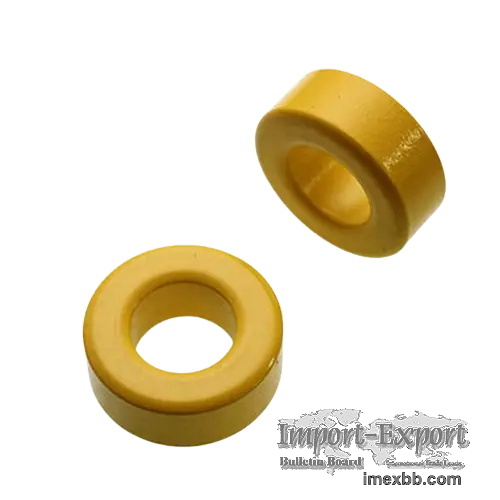 |
 |
Home > Offers to Sell > Minerals & Metals > Others > Others
| Contact: | magneticcube |
|---|---|
| Company: | Shenzhen Magnetic Cube Technology Co.,Ltd. |
| 2/F, Building C, Xinwei Run Science and Technology Park, No.8 Furong Road, Songgang, Bao'an, Shenzhe | |
| Shenzhen 518000 | |
| China | |
| Phone: | 75523018051 |
| E-Mail: | |
| Date/Time: | 4/9/24 2:42 GMT |
Magnetic Core
A Magnetic Core is a device used for storing and transforming electromagnetic
energy. Made primarily of iron or other magnetic core materials, it is widely
used in power converters, electric motors, inductors, and other electronic
devices, serving to enhance energy efficiency and stabilize current.
Specific Information for Magnetic Core
Magnetic cores are an integral part of many custom inductor designs, as they
help enhance the inductance and magnetic field strength. Here is some specific
information about magnetic cores:
Types of Magnetic Cores: There are various types of magnetic cores used in
inductors, including custom ferrite cores, powdered iron cores, laminated
cores, and toroidal cores. Each type has its own unique properties and is
suitable for different applications.
Ferrite Cores: Ferrite cores are made from a ceramic material composed of iron
oxide and other metal oxides. They have high magnetic permeability and are
commonly used in high-frequency applications due to their low losses and
excellent magnetic properties at high frequencies.
Powdered Iron Cores: Powdered iron powder core are made by compressing iron
powder into a desired shape. They have high magnetic permeability and are often
used in power applications due to their ability to handle high currents and
high magnetic flux densities.
Laminated Cores: Laminated cores are made by stacking thin layers of magnetic
material, such as silicon steel, to reduce eddy current losses. They are
commonly used in low-frequency applications where low core losses are
important.
Toroidal Cores: Toroidal cores are ring-shaped cores with a hole in the center.
They provide a closed magnetic circuit, resulting in low magnetic leakage and
high inductance. Toroidal cores are often used in applications where compact
size and high efficiency are required.
Core Materials: The choice of core material depends on factors such as
frequency range, power handling capacity, and desired performance
characteristics. Different core materials have different saturation levels,
temperature stability, and frequency response.
Core Losses: Magnetic cores can experience losses due to hysteresis and eddy
currents. Hysteresis losses occur when the magnetic field is repeatedly
reversed, while eddy current losses occur due to circulating currents induced
in the core material. Minimizing core losses is important to improve the
efficiency and performance of the inductor.
Core Selection: Selecting this inductance component involves considering
factors such as the required inductance value, operating frequency, current
handling capacity, temperature stability, and size constraints. Manufacturers
provide datasheets and application notes to assist in selecting the appropriate
core for a specific inductor design.
How to Select a Magnetic Core?
Selecting a Magnetic Core involves several factors:
1. Material: The core material determines the magnetic properties. Common
materials include iron, silicon steel, nickel-iron, and ferrite.
2. Size and Shape: The core’s size and shape affect its inductance and power
handling capabilities.
3. Frequency Range: Different core materials perform better at different
frequencies.
Power Handling: The core must be able to handle the power level of the
application.
4. Cost: The price of the these electric circuit components can vary greatly,
so it’s important to balance cost with performance requirements.
Remember, the best magnetic core for your application depends on your specific
requirements.
The Manufacturing Process of Magnetic Cores
The manufacturing process of magnetic cores involves several steps, each of
which is crucial to the performance of the final product. Here’s a general
overview of the process:
Material Selection: The first step is to choose the right material for the
core. This could be a type of metal, such as iron, or a ferrite compound. The
choice of material will depend on the intended use of the core, as different
materials have different magnetic properties.
Powder Preparation: The chosen material is then ground into a fine powder. This
powder is often mixed with a binder to help it hold its shape in the later
stages of the process.
Shaping: The powder is then shaped into the desired form. This is usually done
by pressing the powder into a mold under high pressure. The shape of the mold
will determine the shape of the final core.
Sintering: The shaped core is then heated in a process called sintering. This
causes the particles of the material to bond together, forming a solid mass.
The sintering process also helps to align the magnetic domains within the
material, enhancing its magnetic properties.
Cooling: After sintering, the core is allowed to cool slowly. This helps to
prevent cracks and other defects from forming in the material.
Finishing: The cooled core is then finished to the desired specifications. This
may involve grinding or machining the core to achieve a precise size or shape,
or applying a coating to protect the core from corrosion.
Testing: The final step is to test the core to ensure it meets the required
performance standards. This may involve measuring the core’s magnetic
properties, such as its permeability or coercivity.
It’s important to note that the exact process can vary depending on the type
of magnetic core being produced and the specific requirements of the
application.
If you want to know more kinds of inductive components, please visit our
website.
SOURCE: Import-Export Bulletin Board (https://www.imexbb.com/)
Similar Products:Not exactly what you are looking for? Post an Offer to Buy!
![]()
© 1996-2010 IMEXBB.com. All rights reserved.
|
|
|






